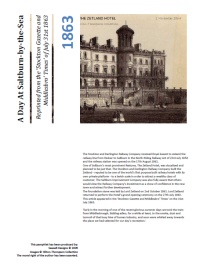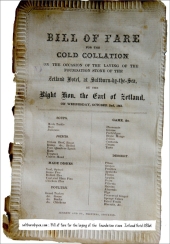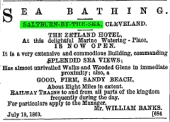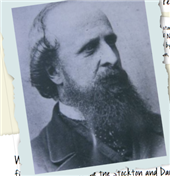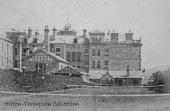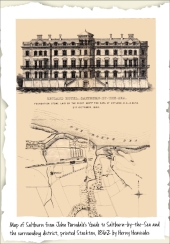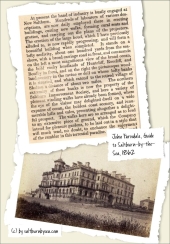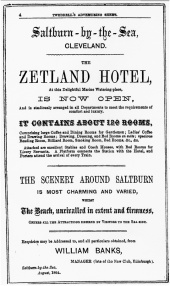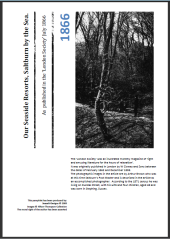Discovering Saltburn's rich heritage ... the Zetland Hotel.
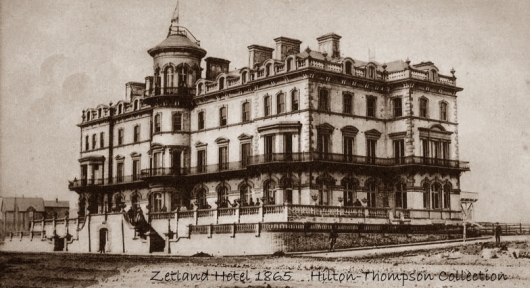
One of Saltburn’s most prominent features, The Zetland Hotel, was visualised and planned to be just that. The Stockton and Darlington Railway Company built the Zetland - reputed to be one of the world’s first purpose built railway hotels with its own private platform - to a lavish scale in order to attract a wealthy class of customer. The Saltburn Improvement Company was also fully aware that others would view the Railway Company’s investment as a show of confidence in the new town and attract further development.
A proposal is made...
At a half yearly meeting of the S & D railway company on 2nd February 1861 Thomas Meynall, chairman of the company, reported that there had been an expenditure of £12,000 on new lines, particularly on the Saltburn branch. At this same meeting Henry Pease made his proposal for the building of a railway hotel at the Saltburn terminus in order to encourage the development of the new town, commenting on the excellent potential of the site as a holiday resort.
Having convinced the directors of the eligibility of this investment a premium was offered for designs for the building. At the same meeting a proposal was made that 'no intoxicating liquor be sold on the proposed premises.' This proposal was not adopted.
The design contract was won by William Peachey, a Darlington architect, and tenders for the building, under Peachey's supervision, were invited to be submitted to the S & D railway office in Darlington by the 25th July of that same year. The foundation stone for the hotel was laid by Lord Zetland on 2nd October 1861 and the stable block at the rear of the hotel appears to be the first part of the building to be completed. Lord Zetland returned to perform the Hotel’s grand opening ceremony on the 27th July 1863.
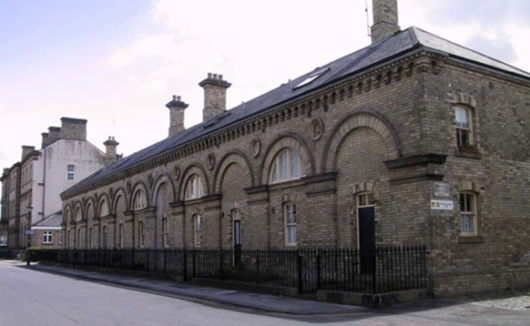
The Zetland Hotel Stable Block, now converted into residential units.
In his visitor’s handbook of 1863, George Tweddell wrote that the Hotel was built: ... in the Italian Style... of firebricks... It is five storeys in height, but there are no windows in the front elevation of the lower storey.The front and sides have spacious terraces, with perforated ballustrades of terra-cotta, surmounted with vases of flowers: and a neat balcony runs along the whole front of the middle storey. A semi-circular tower rises in the centre of the front, which is used as a telescope room, and is provided with another balcony; and both from the top of this tower and the balcony the view is gorgeous. The hotel contains about ninety rooms, comprising about fifty bedrooms, a large dining and coffee room, a ladies coffee and drawing room, reading room, smoking room, billiard room etc
A second description of the building records:
The Zetland Hotel occupies a very commanding site fronting the south, and is an erection of palatial proportions and appearance, in the Italian style of architecture, from the designs of Mr Peachey, of Darlington. The foundation stone was laid by the Right Honorable the Earl of Zetland, in the year, 1861. The main front is five storeys in height, and 180 feet long; a broad terrace, approached by two flights of steps, runs along the front and sides, with balustrades which are here and there ornamented with elegant vases, filled with choice and brilliant flowers. A neat cast iron balcony runs round the second storey, from which a capital view is obtained of the surrounding locality. In the centre of the building is a semi-circular projection, in the upper portion of which is the telescope room, which forms a splendid observatory, and terminates in a tower rising above the rest of the ediface. The summit of this tower is gained by a staircase and on it is fixed a flagstaff, from which the Uniion Jack flutters in the breeze.
Samuel Gordon
The Watering Places of Cleveland, 1869
Unfortunately, plans and specifications for the Zetland do not seem to have survived and the cost of the building and the fitting out vary from source to source.
As well as the rooms mentioned by Tweddell the Hotel boasted lawn tennis courts facing Dundas Street. Also featured were hot and cold sea and fresh water baths.
The special railway platform was another luxury. After running into Saltburn station the main line continued to within a few yards of the hotel’s rear door. This was covered by a roof to shield arrivals from inclement weather.
The hotel proved to be extremely popular and in 1876 magistrates granted an extension of opening hours from 10.00pm to 11.00pm to encourage trade. Alcoholic drinks however, were still not allowed for consumption on the open terraces. In 1882, John Richardson was fined 5/- for drinking a glass of beer outside the hotel. The manager of the hotel, Mr Verini, was also fined 5/- for supplying him.
By the early 1970’s confidence and investment in the town’s infrastructure and buildings was at an all time low. Some of the larger hotels closed and were eventually converted into flats, others struggled to survive. In 1983/84 the Cleveland Building Preservation Trust were finally able to start on their award winning conversion of the former Zetland Hotel Stable Block into 9 residential units. Eventually the Zetland Hotel also finally closed and the building was converted into luxury apartments.
Research by Rebecca Hilton. Collecting primary source materials, articles and extracts from books related to the development of both Saltburn's and trying to validate them has offered conflicting information, much of which is often difficult to validate as many sources can prove to be unreliable e.g. newspapers or census data. Every effort has been made to ensure that the information on the history of the town presented here is as accurate as possible.

